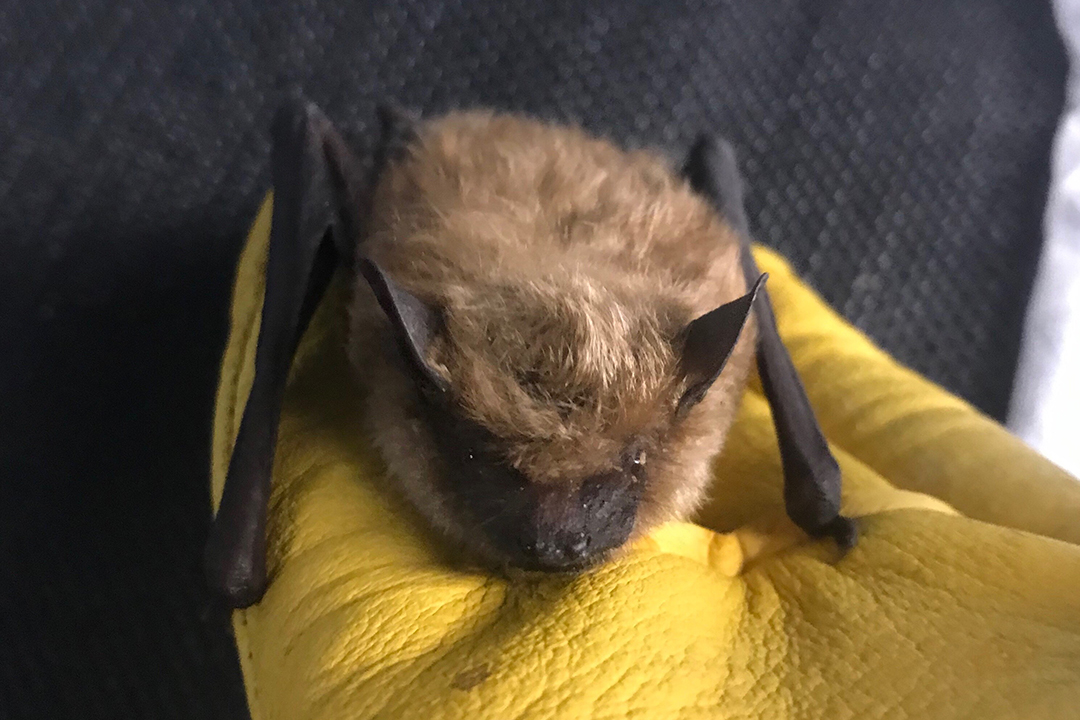
Bats’ immune systems key to understanding global epidemic diseases
Why is it that bats don’t get sick when infected with viruses that can be deadly in humans?
By Anna WilkinsThat’s one of the questions that researchers in the University of Saskatchewan’s Bat Zoonoses Laboratory are trying to answer. The second question on their list is how do various stressors change the balanced bat-virus relationship — leading to increased viral activity?
“Bats are pretty amazing; viruses that make us and other animals very sick don’t seem to affect them,” says Dr. Vikram Misra, who leads the lab’s research team. “They also don’t seem to get cancer the same way that other animals do.”
The team’s work focuses on two species of local bats: the big brown bat and the little brown bat. To date, researchers know very little about how the immune systems of these little mammals function, particularly against viruses.
Viral diseases such as severe acute respiratory syndrome (SARS), Ebola virus, and Middle Eastern respiratory syndrome (MERS) — which are caused by coronaviruses — have killed thousands of people around the world. What these diseases have in common is that they all originated in bats and “spilled over” into the human population.
Over 75 per cent of emerging diseases come from animals, and bats are a major player in this situation. Global demand for land development is causing humans and bats to live in closer proximity, ever increasing the risk of disease transfer.
With bats and humans living closer together, increases in viral shedding due to stress can potentially have far greater impacts than in the past. Learning about how stressors can impact viral levels in bats has implications for not only human health, but for bat conservation as well.
One of the major issues for bats in Canada is a fungal infection called “white-nose syndrome,” caused by the pathogen Pseudogymnoascus destructans. This pathogen infects the wings and nose of bats and interferes with their hibernation, resulting in death.
To date, millions of bats in North America have perished from this disease.
Research conducted by the WCVM’s research team has shown that the stress on the bat’s body from being infected with white-nose syndrome increases the amount of the Myotis lucifugus (little brown bat) coronavirus in the intestines of little brown bats. The researchers also found that arousal from winter hibernation reactivates the Eptesicus fuscus gammaherpesvirus in big brown bats.
Eptesicus fuscus gammaherpesvirus is a virus that was discovered in 2018 by Sonu Subudhi, a former graduate student who was part of the WCVM’s Bat Zoonoses Lab. The virus infects big brown bats, and most bats are infected with it. Much of the current research in the WCVM lab uses this virus as a model.
Some researchers have suggested that hibernation as well as pregnancy and birth may be additional stressors that tip the bat-virus balance in favour of the virus.
To investigate this hypothesis, members of the WCVM’s Bat Zoonoses Lab placed 25 bats in a custom-made hibernation chamber at the college during the winter of 2018-19. By comparing pre- and post-hibernation levels of virus and viral antibodies in these bats, research team members hope to learn more about the potential impact of hibernation.
Researchers also visited the homes of people in the Saskatoon area who had bats living in their attics, with the hope of finding maternal colonies of pregnant females to sample. This pilot project’s goal is to compare viral and viral antibody levels in pregnant bats’ blood before and after giving birth to their pups (babies).
As these two projects illustrate, work being done by WCVM researchers could potentially have an impact on future human health research.
“If we can figure out why bats don’t get sick with viral diseases and cancer, we may be able to discover new treatments for these diseases in people,” says Misra.
The team’s bat research work is financially supported through a Natural Sciences and Engineering Research Council of Canada (NSERC) Discovery Grant.
Anna Wilkins of Victoria, B.C., is a second-year veterinary student at the Western College of Veterinary Medicine (WCVM) on the University of Saskatchewan campus. Her story is part of a series of articles written by WCVM summer research students.
Stressed-out bats
- Many factors are putting stresses on bats today and most of them are from human influences — such as deforestation and the increased use of wind turbines for power. With bats and people living closer together, increases in viral shedding due to stress can potentially have far greater impacts than in the past.
- In 1998, deforestation to make way for increased swine production in Malaysia caused fruit bats to begin living on pig farms. A disease called Nipah virus was transferred from the bats to pigs and from pigs to humans, resulting in a disease that to this day has no cure.
- In 2019, a heat wave in British Columbia resulted in many bats dying of heatstroke inside bat boxes. Limited amounts of roosting sites caused the bats to be unable to switch to cooler roosts, and they succumbed to heat in the roosts they inhabited. Researchers are investigating how this situation can be prevented.
